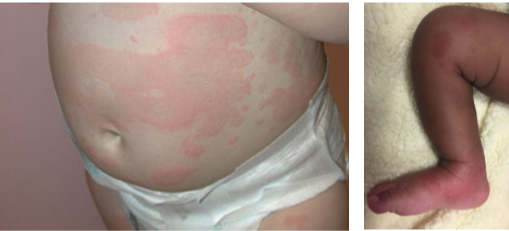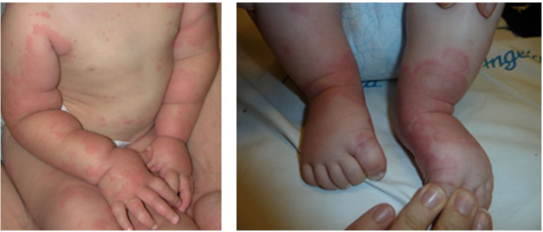Hives, also known as urticaria, are pink or red bumps in the skin. They are sometimes described as welts. Hives usually appear out of the blue without warning. Each hive tends to flatten out over a few hours, but new bumps can continue to appear for several days or longer.
What do hives look like?
They can be small and round red bumps or larger swellings of all different shapes. Sometimes they are even ring or donut-shaped or shaped like a target. The rings may have normal skin in the middle, or look purplish or bruise-like. Sometimes this purple patch will last longer than the hive itself. Hives are usually itchy. Hives can appear anywhere on the body.
It is common for young children with hives to also get swelling of the hands and feet. This can be uncomfortable, and can cause the child to be fussy and unhappy.


Clockwise from top left: hives (urticaria) on trunk, leg, arms and feet.
Who gets hives?
Children and adults of any age can get hives. Hives are very common. 15-20% of people will get hives at some time in their lives.
What causes hives?
Hives are a reaction to lots of different triggers. Minor infections from viruses are a common cause of hives in young children. Often the child seems well and has no or very few other sick symptoms before the hives begin.
Other things that can cause hives include: foods, medicines, additives to foods and vitamins such as color dyes, other kinds of minor infections such as dental infections, and in some cases even exercise, stress, sunlight, ice or other cold things touching the skin, or very rarely other underlying illnesses. In up to a third of cases, however, a specific cause for hives cannot be found.
How long do hives last?
In most children, outbreaks of hives will end within 2 weeks. Occasionally the hives can keep coming for weeks to months.
How are hives diagnosed?
Hives are usually easily recognized when seen by a healthcare provider. In most cases, there are no good tests to figure out why a child has hives. If outbreaks of hives are lasting for many weeks, further testing may be recommended depending on if the child has any other symptoms.
Treatment for hives
If there is a known trigger for the hives, it should be avoided. As mentioned above, most cases of hives in children don't have a clear trigger that you can avoid.
Antihistamines are the main treatment for hives. Your healthcare provider may recommend over-the-counter cetirizine, loratadine or fexofenadine during the daytime because they do not cause sleepiness. Over-the-counter diphenhydramine may be recommended at night. These medications work best when taken on a regular schedule each day to keep the hives from coming back.
Your doctor may prescribe other treatments for hives that don't respond to antihistamines.
When should I be worried about hives?
Let a doctor know right away and go to the nearest emergency room if your child has swelling or tingling of the mouth, tongue or throat, trouble breathing, trouble swallowing, and/or vomiting with the hives. These symptoms need emergency care.
More information
*Hives images courtesy Sheilagh Maguiness, MD, FAAD, FAAP